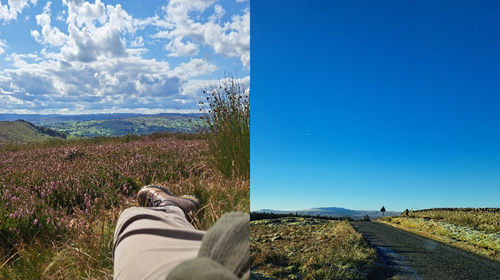It has been a year jam-packed with valuable experiences, and I would highly recommend this placement, or any of the other placement posts offered by the GWCT, to any students reading this.
Not only does it teach valuable ecological skills pertaining to scientific research, study design, approaches to data collection and compiling of databases, but it also teaches many important life skills for a young professional, such as team work to interacting with the wider general public, landowners and land managers.
It is this experience gained in-situ that I find to be the most valuable part of the placement. I certainly feels that no matter where my career path leads me, the experiences I have had and skills that I have learnt in the past 12 months will forever serve me well, and for that I must thank the incredible staff I have had the pleasure of working alongside in the Uplands Team of the GWCT. They have truly made this placement for me, and I cannot express my gratitude enough.

A few views from my time in this part of the world
I’m from a small town in northern England, not too far from the Uplands Headquarters in the grounds of the wonderful Eggleston Hall. Being from a rural area has meant that from a fairly young age I’ve had a keen insight into the management that goes into upland areas through working as a beater (driving the grouse towards the guns through the use of a flag to make noise) on driven grouse shoots and also through simply living nearby and enjoying the well-managed, world renowned countryside on my doorstep. This led me to pursuing a university education in conservation and land management at Harper Adams University in Shropshire.
When the time came to pick a placement, I was quite at odds with the options presented to me. Some placement opportunities offered zero pay, part time work; some even without the guarantee of accommodation. Others advertised an “invaluable opportunity” to clean up after zoo animals or work alongside the local council (in an office all day). I was fairly disillusioned by the whole thing.
That was until I found the advert for the GWCT’s Upland Placement opportunity. It really did change everything for me. It ended up being the only placement opportunity I applied for, and I feel very lucky to have been chosen for the placement from the pool of other candidates.
From my first few days on the job, I was already learning and being given responsibility. Daunting, but again, invaluable experience. My first few months were focused on vegetation surveys for a variety of projects, which included rush coverage assessments, assessments of the botanical composition and structure of red grouse nest sites, and surveys analyzing the recovery of vegetation post management (cutting and burning of heather on peat bogs).
There was a clear focus on “real” research and the practical side of ecological functions and processes. This is what spoke to me the most, and reinforced my belief that management is absolutely needed in this part of the world.
One project that I have found very interesting is a project under the umbrella of Natural England’s Nature Recovery scheme involving both bird and woodland surveys conducted throughout the year (which I hope to use the data to do my dissertation on when back at university). To begin with, we identified planted woodlands in the study area that had the potential to provide food and shelter for Black Grouse over the winter period.
Winter surveys were then conducted in the months of January, February and March to see whether Black Grouse were present in and around the woodlands during winter. It was a cold but jolly job. This was followed by bird surveys during April and May, where 1 kilometer transects were walked from the woodlands and any birds seen or heard were recorded.
The aim was to gather data on wading birds commonly found in the uplands and their distribution in the survey area in relation to these planted woodlands. Surveys of the woodlands themselves were then conducted in June, July and August to gather data on the woodland characteristics, such as tree height, species composition and tree density.
These variables can all have an influence on wading bird behavior as well as giving us a rough idea of the age of the woodland. Woodlands that have just been planted, or have not grown well from tubes, will not be mature enough to provide meaningful overwinter food or shelter for Black Grouse.
Other projects I have also taken part in include a GPS-tagging project to gather information on Black Grouse brood foraging and survival, hydrological work focusing on the effect of heather management strategies on the water table, laboratory work focusing on red grouse and the parasitic worm Trichstrongylosis tenuis that often afflicts them, and the tracking and retrieval of telemetry tags placed on red grouse to study their movement and breeding success.

Left: Winter woodland surveys | Right: The remains of one of the tagged hens
It has been a whirlwind of a placement year and I am grateful to have taken part in such fun research. The Uplands Team is fantastic, and I would recommend this placement, or job role, to anyone who has the opportunity to do it.